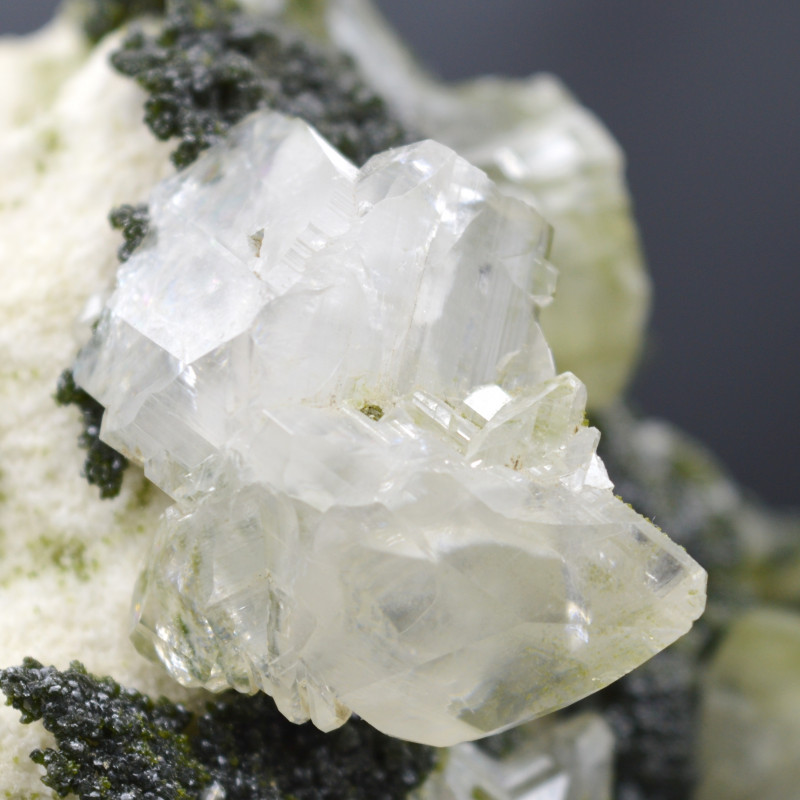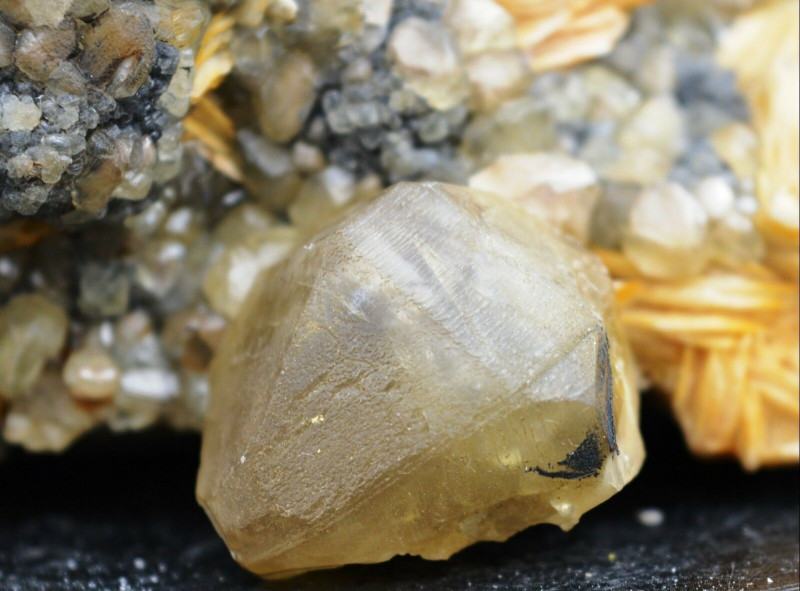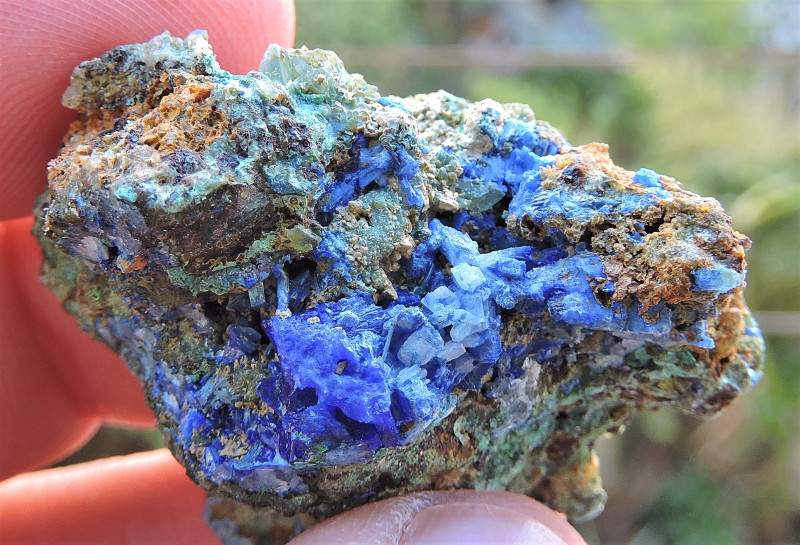
Cerussite Gemstone: Meaning, Uses & Value Information
 Cerussite (pronounced si-ruhs-ahyt or seer-uh-sahyt) is a lead gemstone commonly found colorless or cream-colored. It’s one of the only stones besides diamond that has an adamantine luster, the highest luster possible.
Cerussite (pronounced si-ruhs-ahyt or seer-uh-sahyt) is a lead gemstone commonly found colorless or cream-colored. It’s one of the only stones besides diamond that has an adamantine luster, the highest luster possible.
The vast majority of cerussite for sale today is sold as a raw crystal or specimen. Options for crystals are seemingly endless, with cerussite claiming more twinning shapes than any other mineral.
The stone’s complex formations aren’t its only captivating quality. In this guide, you’ll discover all of cerussite’s properties, healing powers, prices, and more!

What Is A Cerussite Crystal?
Cerussite is an abundant semi-precious stone, but faceted cerussites are rarer than any precious gems, as it’s painstaking to cut.
What can cerussite be used for? For one, raw cerussite crystals are popular collector minerals. It’s sometimes a lead ore.
Scientists have grown synthetic cerussites for research. Historically, cerussite had many cosmetic uses (covered later).
Colorless cerussite’s similarity to diamond means you can substitute it as an April birthstone, though diamond jewelry is more readily available than cerussite jewelry. Individually, cerussite is a Virgo zodiac stone.
Cerussite Specifications & Characteristics
As a lead carbonate, the cerussite formula is PbCO3. It can be about 78 percent lead, making it quite heavy.
Cerussite mineral joins aragonite, witherite, and strontianite in the aragonite group of orthorhombic carbonates.
You can identify cerussite by looking for its pale coloring, high refractive index (over-the-limit on refractometer), and softness on the Mohs scale. It will dissolve and effervesce (start bubbling) in diluted nitric acid, but this test is destructive.
Cerussite’s mineral properties are:
Mohs hardness: 3-3.5
Color: Colorless, cream, white, gray, green, yellow, blue, pink, brown, red, black
Crystal structure: Orthorhombic
Luster: Usually adamantine or vitreous (glassy); Can be pearly, submetallic, or resinous
Transparency: Transparent to opaque
Refractive index: 1.80-2.08
Density: 6.46-6.57
Cleavage: Distinct/Good, 2-directions on [110] & [021]
Fracture: Conchoidal or uneven
Streak: White
Luminescence: Sometimes fluorescence; Pink-orange or yellow in LW-UV & light blue or green in SW-UV
Optical effects: Rarely chatoyancy
Dispersion: 0.055 (strong)
Birefringence: 0.275

Types of Cerussite
Cerussite’s only technical variety is the canary or yellow-green chrome (or chromian) cerussite. This name is somewhat deceiving — the initial theory that its color is solely from chromium was disproven.
Chromium may contribute, but it’s not the sole factor. Other theories include crocoite inclusions, organic carbon staining, natural irradiation, or a combination of these.
There are also cerussite variants (too similar to be varieties) distinguished by their impurities:
Argentiferous Cerussite: Silver-bearing variant typically from small silver-mineral inclusions
Iglésiasite or Zincian Cerussite: Zinc-bearing variant named after its first locality in Iglesias, Italy
Hydrocerussite: Rare variant containing hydroxide
Interestingly, hydrocerussite played a major role in cerussite’s history!

Cerussite Meaning & History
The cerussite crystal symbolizes light, transformation, and spirituality. The inspiration for cerussite’s name is less mystical. Before it received its current name, basic terms for the stone included:
Acrusite
White lead
White lead ore
Carbonate of lead
Lead spar
“Cerussite” comes from the Latin cerussa, meaning “white lead.” Though “cerussa” appears in records from 400 BC, the mineral wasn’t officially described yet.
In 1565, Swiss naturalist Conrad Gessner first mentioned it as “cerussa native.” French mineralogist F.S. Beaudant published a description under “céruse” in 1832, but Austrian mineralogist W. Haidinger established the “cerussite” name in 1845.
Ancient Uses
Nearly every historical use for cerussite was for cosmetics or paint pigment.
Ancient Egyptians first used cerussite paste for white face paint. It wasn’t just to look attractive — they believed beauty was sacred.
Greeks used the paste to give their skin a porcelain appearance, emulating the gods of Greek myths. Similarly, ancient Romans started the cultural practice of skin-whitening using cerussite.
Romans believed pale, blemish-free skin was the epitome of feminine beauty. Though, obvious makeup (what we’d call “caked on”) was symbolic of prostitution.
The practice continued in Medieval Europe, when appearing healthy was sought-after, given the deficiency of medicine and the prominence of diseases like smallpox and tuberculosis.
As medicine and societies advanced, social status shifted from health to wealth.
Renaissance-Era: Ceruse and Rembrandt
The 1500s saw the rise of Venetian ceruse. Ceruse was a skin-whitening and complexion-balancing cream made of hydrocerussite.
Venice, Italy, boasted the highest-quality ceruse. Combined with clever marketing and premium prices, this cream de la crème (so to speak) was in high demand among nobility.
One such noble was Queen Elizabeth I of England, believed to regularly use Venetian ceruse. Another example is Renaissance fashion icon Isabelle d’Este. Her regular use of ceruse led to permanent skin damage.
Likewise, lead poisoning after years of using ceruse likely led to the 1760 death of English socialite Maria Coventry in 1760. Many called the affair “Death by Vanity.”
Outside of makeup, cerussite also lent well to paint pigments.
Ever heard of Rembrandt? The exact pigment mixture behind his three-dimensional work baffled artists for centuries. In 2019, scientists discovered the mystery ingredient: cerussite!
Modern History: 1700s to Now
By the 1700s, researchers recognized the potentially severe health risks of lead, from cosmetics especially.
However, the true severity wasn’t revealed until 1979, when American doctor Herbert Needleman conducted official research on lead poisoning’s effects. Today, lead in products is more regulated, though most cosmetics still contain traces.
Luckily, cut cerussite gemstones are safe, and you can use them for crystal healing!

Cerussite Healing Properties
Cerussite is a unique healing stone, possessing the uplifting, spiritual qualities of white gemstones, while its heaviness makes it grounding like darker gems. White cerussite is a crown chakra stone, opening you to spiritual growth and self-awareness.
Meanwhile, yellow cerussite opens the sacral chakra’s creativity, and green cerussite balances the heart chakra for love and acceptance.
What is cerussite good for physically and emotionally?
Physical Healing
Crystal healers use cerussite for:
Counteracting jet lag
Lowering anxiety & stress
Treating dementia
Stimulating problem-solving, logic, and focus in the brain
Emotional Healing
Emotionally, cerussite is believed to increase hope and resilience during dark or transitional times, helping you accept and adapt. Feeling stressed or overwhelmed? Cerussite can bring mental clarity and calm.
Spiritual Healing
The cerussite crystal is associated with spiritual alchemy, an ancient belief system regarding transformation. Instead of transforming lead into gold, spiritual alchemists transform their spirit to reach the “gold” of enlightenment.
Like Buddhism, it follows multiple stages and cerussite helps facilitate the process. It starts at calcination (examining how you’re holding yourself back) and ends at coagulation (liberation to merge with your higher spiritual self).

Cerussite Gemstone Properties
Cerussite’s value comes from some standard properties like color, cut, clarity, and carat weight, but crystal habit is also crucial.
Firstly, what color is cerussite?
Color
Cerussite is usually creamy or colorless with tints of yellow, green, or gray. Other possible colors are brown, blue, red, pink, deep gray, or even black.
Copper impurities cause green hues, while galena inclusions cause dark gray or black hues. Various impurities and inclusions like green malachite cause the other colors.
Unlike most gems, color doesn’t significantly influence cerussite’s value, especially when compared to the influence of its crystal habit.
Crystal Shape
The most common crystal habits in cerussite are table-like (tabular) or prismatic crystals, along with flat, tiny plates. It can even form domes and pyramids. Most valuable, however, are its many twinning forms.
But what is twinning? Twinning happens when a mineral forms multiple crystals that meet and diverge, creating a symmetrical shape.
Most twins only have two crystals, like the V-shaped “elbow twin.” Cerussite elbow twins have attractive rounded faces. Plus, some of these have less defined spaces in the “V,” creating a heart.
Cerussite twins with more than two crystals can form stars, cross-shaped cruciforms, six-pointed “sixlings,” and six-rayed “stellate” stars. The stone can even form twins with dozens of crystals connected!
One of the most attractive shapes is the “snowflake,” composed of lots of thin, interconnected (reticulated) crystals.
Transparency & Clarity
Cerussites closer to transparent are more valuable. Of course, inclusions can affect its transparency and clarity. We mentioned malachite and galena, but other common inclusions include:
Certain inclusions can raise cerussite’s value, like malachite.
Sometimes, fibrous inclusions can cause chatoyancy (the “cat’s eye” effect). These stones are called “cat’s eye cerussite” but must be cut correctly.
Cut
Faceted, transparent cerussites display luster equivalent to diamond, but dispersion (fire) that exceeds diamond. Unfortunately, the stone’s multiple cleavages, softness, brittleness, and heat sensitivity make faceting extremely tricky.
The very rare faceted cerussite gems, only cut by experts, can have unique shapes like twisted pentagons, plus traditional radiant or emerald shapes.
Cat’s eye cerussites must be cut as cabochons to see the reflecting light. Most often, cerussites are sold as raw crystals.
Carat Weight & Size
Cerussite can grow to huge sizes, especially from certain locales. Namibia, for example, produces transparent cerussite rough that could lend gems over 1,000 cts (if cutting wasn’t so tricky).
Namibia also produced the impressively faceted “Light of the Desert” that weighs nearly 900 cts! The next largest cerussite, around 200 cts, doesn’t come close to this size. Arizona, USA, and Namibia have produced cat’s eye cabochons from 2-6 cts.
One aspect to keep in mind is cerrusite’s incredibly high density, which means stones with high carat weights will be smaller dimensionally than other gems of the same carat weight.
Before it reaches these sizes, how is cerussite formed?

Cerussite Formation & Sources
Cerussite is a secondary mineral, meaning it starts as one mineral but changes into cerussite because of forces like weathering or new chemicals introduced.
Here, galena comes first as the primary mineral, which is the reason cerussite and galena are often discussed together.
Deep underground, carbonated, acidic water causes galena to decompose. The mineral’s lead breaks off, then merges with nearby carbonates to form cerussite.
Geographically, where can I find cerussite?
Mining Locations
The most important source for gem-quality cerussite is Namibia. Morocco is also significant for attractive twinned crystals.
Other notable cerussite sources are:
Australia
Austria
Bohemia
China
Czechia
Congo
Germany
Greece
Iran
Italy
Mexico
Siberia
Slovakia
Spain
UK (Scotland, England)
USA (Arizona, California, Colorado, Idaho, Maryland, Montana, Nevada, New Mexico, Pennsylvania, South Dakota, Utah)
Zambia
Onto the big question: how much will cerussite cost you?

Cerussite Price & Value
The priciest cerussites are faceted, though cabochons carry hefty price tags as well. Faceted cerussite ranges from $25-$100 per carat. Cat’s eye cerussite cabochons fetch $45-$75 per carat.
Raw crystals have broader ranges, starting at $5 and reaching upwards of $6,500. Transparent crystals are costlier, around $50 to $1,000. Snowflake crystals go for $45 to $6,600.
Rough mixed with malachite can also be pricey, ranging from $18 to $430, or $900 with chrysocolla present, too. Other mixtures are less costly, like:
With barite: $15-$30
With pyrite: Around $75
With galena: $15-$250
With this kind of investment, proper gemstone care is crucial!
Cerussite Care and Maintenance
Unfortunately, cerussite jewelry is incredibly fragile, only appropriate for careful, infrequent wear. Even a cerussite ring with protective settings can easily break.
Additionally, lead makes cutting rough cerussite a major health risk, requiring the highest expertise and safety precautions.
With proper safety gear, you can use a cleaning solution like dithionite or Iron Out on rough cerussite — if it’s the same temperature as the stone.
The stone is sensitive to heat and sudden temperature changes, so it should be kept in a temperature-controlled, cool container.
Captivated by Cerussite Crystals?
Though its ancient uses faded out, cerussite crystals are still gorgeous specimens for decor or spiritual healing. This gem’s illuminating symbolism and array of fascinating shapes reminds you to let your unique self shine!
Search the Gemstone Encyclopedia
Related Auctions
Related Articles
Originally the Birthstones or gemstones were associated with a zodiac sign or the month of a individuals birth. Find out what your stone is and view the stones we have for sale
8th Feb 2021
There are dozens of quartz and chalcedony gems with various colors and patterns. Learn all about quartz properties and every type of quartz, from amethyst and agate to plasma and phantom quartz!
15th Oct 2020
Hackmanite is a pink to violet sodalite gem known for its unique color-change and luminescence. Learn why hackmanite is special, from its rare qualities to the types of hackmanite jewelry available.
28th Mar 2018
Latest Articles
Catapleiite is a lesser-known mineral and rare gemstone often found as stunning tabular rosettes near other rare stones. Discover the history, prices, benefits, and properties of catapleiite!
28th Apr 2025
Yugawaralite is a rare colorless, white, or pinkish zeolite crystal named for its discovery in Yugawara, Japan. Here we uncover the multifaceted history, properties, prices, and uses of yugawaralite.
24th Mar 2025
Simpsonite is a lesser-known mineral known on the gem market for its durability, yellow-orange color, and rarity. Discover all the properties, uses, prices, and history of simpsonite.
3rd Mar 2025
Article Categories
How To's is where you will find helpful articles from gem Rock Auctions on how to cut gemstones, select gemstones and buy gemstones.
9 Articles




